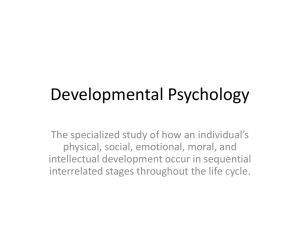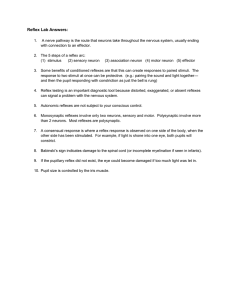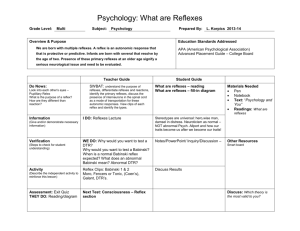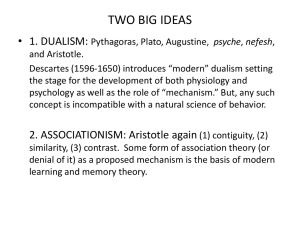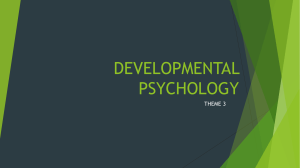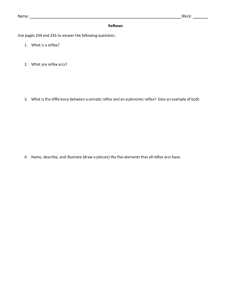Infant Growth and Development Important Points Samah K. Aburahma, MD
advertisement
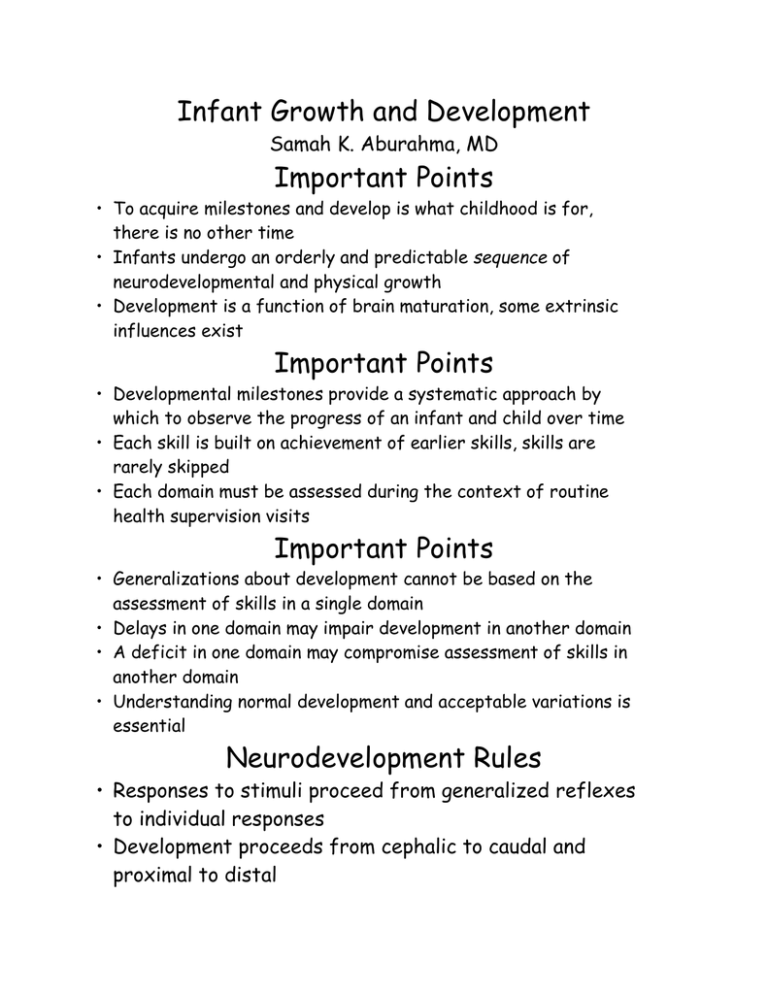
Infant Growth and Development Samah K. Aburahma, MD Important Points • To acquire milestones and develop is what childhood is for, there is no other time • Infants undergo an orderly and predictable sequence of neurodevelopmental and physical growth • Development is a function of brain maturation, some extrinsic influences exist Important Points • Developmental milestones provide a systematic approach by which to observe the progress of an infant and child over time • Each skill is built on achievement of earlier skills, skills are rarely skipped • Each domain must be assessed during the context of routine health supervision visits Important Points • Generalizations about development cannot be based on the assessment of skills in a single domain • Delays in one domain may impair development in another domain • A deficit in one domain may compromise assessment of skills in another domain • Understanding normal development and acceptable variations is essential Neurodevelopment Rules • Responses to stimuli proceed from generalized reflexes to individual responses • Development proceeds from cephalic to caudal and proximal to distal • Development progression is from dependence to independence Abilities and reflexes of the newborn • Eye reflexes: – – – – Blink reflexes: response to various stim. Doll’s eye response: in the first 10 days Pupil reflexes: at birth Resistance to passive opening: at birth Primitive Reflexes • Survival reflexes that evolve in utero sequentially • Automatic stereotyped movements executed by the brain stem • Inhibited by higher cortical centers as the stereotyped movement pattern is broken up and integrated into complex voluntary movements Primitive Reflexes – Oral reflexes: Sucking, rooting, disappear around 3 months – Grasp reflexes: palmar grasp disappears at 3 months, plantar grasp disappears at 6 months • Plantar and palmar grasp reflexes Primitive Reflexes • Moro reflex: disappears by 3 months • Trunk incurvation (Galant’s reflex): disappears at 9-18 months • Placing and walking reflexes: disappear by 5-6 weeks • Moro reflex • Galant’s reflex Primitive Reflexes • The tonic neck reflexes: – Asymmetrical tonic neck reflex (ATNR): disappears by 3-4 months – Symmetrical tonic neck reflex (STNR): appears at 6-8 months and disappears with crawling – Landau reflex: develops at 3-10 months and is lost by 36 months – STNR and Landau are “bridging reflexes” Asymmetrical tonic neck reflex Symmetrical tonic neck reflex • Landau reflex Postural and Protective Reflexes • Righting reflexes: – Occulo-head righting reflex – Labyrinthine-head righting reflex – Body righting • Parachute reaction: appears 6-9 mo., persists through life Head righting reflexes Parachute Reflex Tools of developmental assessment • History • Physical examination • Denver developmental chart…crude • Specialized developmental testing tools • History – – – – – • • • • Prenatal and perinatal hx…preterm delivery Environmental history Relevant illnesses-malnutrition Rate of development Past achievements Developmental history Simple language Whether skill developed, when, how often Be precise: “smiling”, “talking”, “sitting”, etc Assess reliability of the history • Aims at: – – – – • • • • • History Physical Exam Developmental assessment by exam Verifying developmental history Assessment of quality of milestone Assessment for etiology of any delays identified Physical examination Physical growth Primitive reflexes Righting reflexes Protective reflexes Neurological examination • Developmental testing Physical Growth and Development • Red flags in physical growth – Large and small head size – Below or above average size – Dysmorphism Gross Motor Development • Red flags in motor development: – – – – – Persistent fisting beyond 3 months of age Spontaneous postures: frog like, scissoring, opisthotonus Delays in postural reactions, persistent primitive reflexes Abnormal movement patterns Hand dominance prior to 18 months Frog Like Position Scissoring Opisthotonus Fine Motor Development • Highlight is attainment of pincer grasp in first year • In the second year infants move from learning to manipulate, to manipulating to learn • • • • Language Development Prespeech period: 0-10 months Naming period: 10-18 months Word combination period: 18-24 months Language vs. speech: expressive speech is slower than receptive skills Language Development • Delays in language more common than other domains – Attention to receptive and expressive skills, expressive skills develop slower – Expression can take several forms • Speech, gestures, writing, typing, … – May have normal language but delayed speech Language Development • All children with delayed language should receive audiologic testing • • • • Psychosocial development More variable than other domains Bonding: feelings of caregiver towards child Attachment: feeling of child towards caregiver Evolution of the smile Normal variations • Variations in motor activity: – Some walk as early as 9 months – Bottom shuffling: on one hand and buttock – Some omit creeping • Sphincter control: great variation • Social and adaptive milestones vary greatly • Motor: – – – – Developmental Screen Red Flags 6 mo: not sitting 15 mo: not walking 2yrs: not climbing stairs 3yrs: not stand on one foot – 4yrs: not hopping Developmental screen • Language: – – – – – – 6mo: not babbling 9mo: no dada/mama 18mo: < 3 words 2yrs: no 2 word phrases 3yrs: not comprehensible 4yrs: no prepositions Developmental Delay • Frequent questions: – – – – Why is my child not sitting/walking He’s different from my other children Why does he walk on his toes He seems too loose/too stiff Developmental Delay • Global developmental delay • Dissociation of delay between domains – Speech and language delay – Gross motor delay – Fine motor delay Global Developmental Delay • Delay in two or more domains • Children with mental retardation (MR) usually have global delays • Global delay is preferable to MR in children younger than 5 years, not all children with global delay will have abnormal IQ tests when older • Mild: 50-70 Mental Retardation – Incidence 20-30/1000 • Severe: <50 – Incidence 3-4/1000 – The more severe the retardation, the more likely an underlying cause is identified Mental Retardation • Etiology is extensive, anything that affects the brain can cause mental retardation. For severe and mild MR – Prenatal: 70 and 51% – Perinatal: 4 and 5% – Postnatal and acquired: 5 and 1% Mental Retardation • Majority of prenatal causes are cytogenetic – Down syndrome: most common microscopically identifiable cause – Fragile X syndrome: most common inherited cause in males – Rett syndrome: most common genetic cause of mental retardation in girls Mental Retardation • Other prenatal causes include – – – – – Congenital hypothyroidism CNS malformations TORSCH infection Toxins and teratogens Inborn errors of metabolism Down Syndrome • Most common chromosomal abnormality among live born infants • Most common cause of mental retardation caused by microscopically demonstrable chromosomal abnormality • 1/1000 live births • Maternal age: Down Syndrome • 33yrs: 1/625 live births have chromosomal anomaly • 45yrs: 130 live birth have chromosomal anomaly • Genetics: – Trisomy 21: 47, +21 – Robertsonian translocation Head and neck: – – – – – – – – Down SyndromeDysmorphic Features Brachycephaly Upslanting palpebral fissures Epicanthal folds Flat nasal bridge Folded or dysplastic ears Small ears Open mouth and protruded, furrowed tongue Short neck Down SyndromeDysmorphic Features • Extremities – – – – – Short broad hands Incurved fifth finger Transverse palmar crease (simian crease) Space between first and second toes Hyperflexibility of joints Fragile X Syndrome • Mild to severe mental retardation, behavioral problems, and speech and language delays • Narrow face, large jaw, elongated prominent ears, macroorchidism • Diagnosed by assessment of CGG repeats (cell culture in follate deficient medium not reliable) • • • • Rett Syndrome Young females Normal early development and head circumference Loss of communication skills Deceleration of head growth • Essential criteria – – – – – – – – – Rett Syndrome Normal per and perinatal period Normal birth head circumference Normal early development Deceleration of head growth Loss of acquired hand skills Loss of communication skills Stereotypic hand movements Absence of hepatosplenomegaly and retinopathy Absence of intrauterine growth retardation • Supportive criteria Rett Syndrome – Awake breathing dysfunction – – – – – – Apnea/hyperventilation Forced air/saliva expulsion, air swallowing Bruxism Seizures/generalized abnormal EEG Gait apraxia Vasomotor instability Congenital Hypothyroidism • Most common treatable cause of MR • Inverse relationship between age at diagnosis and IQ later in life • Asymptomatic at birth, sporadic • Most common cause is thyroid dysgenesis, 15% are hereditary related to inborn errors of thyroid hormone synthesis Congenital Hypothyroidism • Clinical manifestations – Most are asymptomatic…maternal T4 – Lethargy, slow movement, hoarse cry, feeding problems, constipation, macroglossia, umbilical hernia, large fontanel, hypotonia, dry skin, hypothermia, and prolonged jaundice – Increased risk of congenital malformations Congenital Hypothyroidism • Newborn screening programs – Screening of all newborns is routine in most industrialized countries – 2-5 days after delivery – T4 or TSH is measured Congenital Hypothyroidism • Treatment – Overall goal is to assure normal growth and development and psychometric outcome similar to genetic potential – Restoration of normal T4 levels RAPIDLY – Oral T4 is drug of choice, as soon as diagnosis is confirmed Developmental Delay • Global developmental delay • Dissociation of delay between domains – Speech and language delay – Gross motor delay – Fine motor delay Speech and Language Delay • Expressive language delay: the most common delay encountered • Delayed language and speech cause significant social and educational disruption • Etiology – – – – – Speech and Language Delay Hearing loss Mental retardation Autism Dysarthria Specific learning disabilities Hearing Loss • All children with speech and language problems should have an audiometric assessment • Congenital sensorineural hearing loss is the most common birth defect • The greater the hearing loss the greater the deficit • Early diagnosis improves outcome Motor Delay • Motor delay may be combined with other delays, e.g. MR, or isolated • Gross motor delay: e.g. CP, ataxia, myopathy,… – If there is no motor delay, the child does not have CP • Fine motor delay: visual impairment, erb’s palsy, hemiplegia, … Pearls • Assess infant development with every encounter, to develop normally is what childhood is for, there is no other time • Normal development is one of the indicators of good general health • Developmental assessment is not intended for labeling infants or guessing their age, but to pick up problems and act upon them • Developmental assessment…think domains • Developmental milestones make sense and are easy to remember, they are predictable and sequential • PRACTICE MAKES PERFECT
